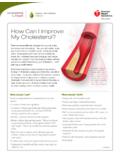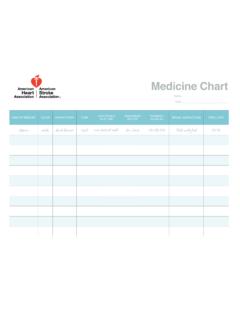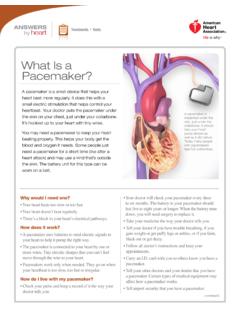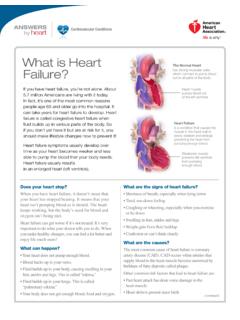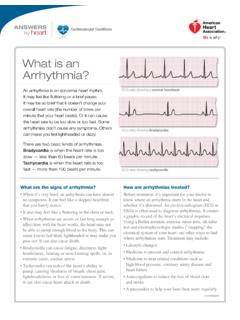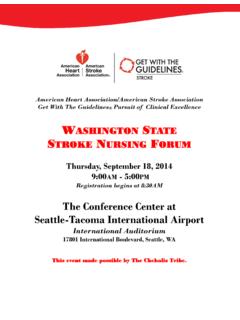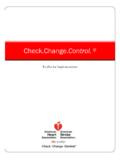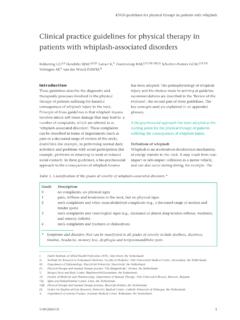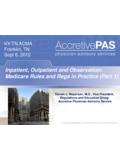Transcription of AHA/ASA Guideline - American Heart Association
1 Nursing, Council on Peripheral Vascular Disease, and Council on Clinical Cardiologyon behalf of the American Heart Association Stroke Council, Council on CardiovascularHoward YonasRosenfield, Phillip A. Scott, Debbie R. Summers, David Z. Wang, Max Wintermark andBart M. Demaerschalk, Pooja Khatri, Paul W. McMullan, Jr, Adnan I. Qureshi, Kenneth Edward C. Jauch, Jeffrey L. Saver, Harold P. Adams, Jr, Askiel Bruno, (Buddy) Connors,Stroke AssociationGuideline for Healthcare Professionals From the American Heart Association / American guidelines for the Early Management of Patients With Acute Ischemic Stroke : APrint ISSN: 0039-2499. Online ISSN: 1524-4628 Copyright 2013 American Heart Association , Inc.
2 All rights published by the American Heart Association , 7272 Greenville Avenue, Dallas, TX 75231 Stroke doi: ;44:870-947; originally published online January 31, 2013;Stroke. Wide Web at: The online version of this article, along with updated information and services, is located on the Supplement (unedited) at: online at: Stroke Information about subscribing to Subscriptions: Information about reprints can be found online at: Reprints: document. Permissions and Rights Question and Answer process is available in theRequest Permissions in the middle column of the Web page under Services. Further information about thisOnce the online version of the published article for which permission is being requested is located, click can be obtained via RightsLink, a service of the Copyright Clearance Center, not the Editorial Requests for permissions to reproduce figures, tables, or portions of articles originally publishedPermissions: at AHA National Center on March 20, 2013 from 870 AHA/ASA GuidelineBackground and Purpose The authors present an overview of the current evidence and management recommendations for evaluation and treatment of adults with acute ischemic stroke.
3 The intended audiences are prehospital care providers, physicians, allied health professionals, and hospital administrators responsible for the care of acute ischemic stroke patients within the first 48 hours from stroke onset. These guidelines supersede the prior 2007 guidelines and 2009 Members of the writing committee were appointed by the American Stroke Association Stroke Council s Scientific Statement Oversight Committee, representing various areas of medical expertise. Strict adherence to the American Heart Association conflict of interest policy was maintained throughout the consensus process. Panel members were assigned topics relevant to their areas of expertise, reviewed the stroke literature with emphasis on publications since the prior guidelines , and drafted recommendations in accordance with the American Heart Association Stroke Council s Level of Evidence grading The goal of these guidelines is to limit the morbidity and mortality associated with stroke.
4 The guidelines support the overarching concept of stroke systems of care and detail aspects of stroke care from patient recognition; emergency medical services activation, transport, and triage; through the initial hours in the emergency department and stroke unit. The Guideline discusses early stroke evaluation and general medical care, as well as ischemic stroke, specific interventions such as reperfusion strategies, and general physiological optimization for cerebral resuscitation. guidelines for the Early Management of Patients With Acute Ischemic StrokeA Guideline for Healthcare Professionals From the American Heart Association / American Stroke AssociationThe American Academy of Neurology affirms the value of this Guideline as an educational tool for by the American Association of Neurological Surgeons and Congress of Neurological SurgeonsEdward C.
5 Jauch, MD, MS, FAHA, Chair; Jeffrey L. Saver, MD, FAHA, Vice Chair; Harold P. Adams, Jr, MD, FAHA; Askiel Bruno, MD, MS; (Buddy) Connors, MD; Bart M. Demaerschalk, MD, MSc; Pooja Khatri, MD, MSc, FAHA; Paul W. McMullan, Jr, MD, FAHA; Adnan I. Qureshi, MD, FAHA; Kenneth Rosenfield, MD, FAHA; Phillip A. Scott, MD, FAHA; Debbie R. Summers, RN, MSN, FAHA; David Z. Wang, DO, FAHA; Max Wintermark, MD; Howard Yonas, MD; on behalf of the American Heart Association Stroke Council, Council on Cardiovascular Nursing, Council on Peripheral Vascular Disease, and Council on Clinical CardiologyThe American Heart Association makes every effort to avoid any actual or potential conflicts of interest that may arise as a result of an outside relationship or a personal, professional, or business interest of a member of the writing panel.
6 Specifically, all members of the writing group are required to complete and submit a Disclosure Questionnaire showing all such relationships that might be perceived as real or potential conflicts of statement was approved by the American Heart Association Science Advisory and Coordinating Committee on December 12, 2012. A copy of the document is available at by selecting either the By Topic link or the By Publication Date link. To purchase additional reprints, call 843-216-2533 or e-mail Executive Summary is available as an online-only Data Supplement with this article at American Heart Association requests that this document be cited as follows: Jauch EC, Saver JL, Adams HP Jr, Bruno A, Connors JJ, Demaerschalk BM, Khatri P, McMullan PW Jr, Qureshi AI, Rosenfield K, Scott PA, Summers DR, Wang DZ, Wintermark M, Yonas H; on behalf of the American Heart Association Stroke Council, Council on Cardiovascular Nursing, Council on Peripheral Vascular Disease, and Council on Clinical Cardiology.
7 guidelines for the early management of patients with acute ischemic stroke: a Guideline for healthcare professionals from the American Heart Association / American Stroke Association . Stroke. 2013;44:870 peer review of AHA Scientific Statements is conducted by the AHA Office of Science Operations. For more on AHA statements and guidelines development, visit and select the Policies and Development : Multiple copies, modification, alteration, enhancement, and/or distribution of this document are not permitted without the express permission of the American Heart Association . Instructions for obtaining permission are located at A link to the Copyright Permissions Request Form appears on the right side of the page.
8 2013 American Heart Association , is available at DOI: at AHA National Center on March 20, 2013 from Jauch et al Early Management of Acute Ischemic Stroke 871 Despite the increase in the global burden of stroke, advances are being made. In 2008, after years of being the third-leading cause of death in the United States, stroke dropped to In part, this may reflect the results of a commitment made by the American Heart Association / American Stroke Association ( AHA/ASA ) more than a decade ago to reduce stroke, coronary Heart disease, and cardiovascular risk by 25% by the year 2010 (a goal met a year early in 2009). The rea-son for the success was multifactorial and included improved prevention and improved care within the first hours of acute stroke.
9 To continue these encouraging trends, the public and healthcare professionals must remain vigilant and committed to improving overall stroke care. This document addresses opportunities for optimal stroke care in the acute phase of the ischemic intended audience of these updated guidelines is healthcare professionals involved in the emergency identifica-tion, evaluation, transport, and management of patients with acute ischemic stroke. This includes prehospital care provid-ers, emergency department (ED) physicians and nurses, stroke team members, inpatient nurses, hospitalists, general medicine physicians, hospital administrators, and ancillary healthcare personnel.
10 These guidelines deal with the acute diagnosis, sta-bilization, and acute medical and surgical treatments of acute ischemic stroke, as well as early inpatient management, sec-ondary prevention, and complication management. Over the past several years, several new guidelines , policy statements, and recommendations on implementation strategies for emer-gency medical services (EMS) within stroke systems of care, imaging in acute ischemic stroke, management of stroke in infants and children, nursing and interdisciplinary care in acute stroke, primary prevention of ischemic stroke, stroke systems of care, and management of transient ischemic attack (TIA) related to acute ischemic stroke have been published by the AHA/ASA .
